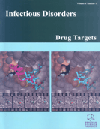- Home
- A-Z Publications
- Infectious Disorders - Drug Targets (Formerly Current Drug Targets - Infectious Disorders)
- Previous Issues
- Volume 7, Issue 3, 2007
Infectious Disorders - Drug Targets (Formerly Current Drug Targets - Infectious Disorders) - Volume 7, Issue 3, 2007
Volume 7, Issue 3, 2007
-
-
Zn Finger Containing Proteins as Targets for the Control of Viral Infections
More LessAuthors: C. C. Garcia and E. B. DamonteThe zinc finger proteins have fascinated many research groups because of their modular assembly, broad range of biological functions and more recently because they are attractive targets for antiviral therapy. The zinc finger domain is a very stable structural element whose hallmark is the coordination of a zinc ion by several amino acid residues, usually cysteines and histidines. These structural motifs are associated with pr Read More
-
-
-
Targeting Iron Acquisition by Mycobacterium tuberculosis
More LessAuthors: Ryan R. Monfeli and Craig BeesonTuberculosis (TB) caused by the pathogen Mycobacterium tuberculosis continues to be a major worldwide health problem. Lack of compliance to the complex, multi-drug therapy regimen has resulted in multidrug-resistant TB and a need for new drug targets. Siderophore molecules used for iron acquisition are good targets because pathogen survival and virulence is directly related to iron availability. Indeed, a key host defen Read More
-
-
-
Targeted Anti Bacterial Therapy
More LessAuthors: Iftach Yacoby and Itai BenharThe increasing development of bacterial resistance to traditional antibiotics has reached alarming levels, thus necessitating a strong need to develop new antimicrobial agents. These new antimicrobials should possess novel modes of action and/or different cellular targets compared with the existing antibiotics. As a result, new classes of compounds designed to avoid defined resistance mechanisms are undergoing pre clin Read More
-
-
-
Strategic Paradigm Shifts in the Antimicrobial Drug Discovery Process of the 21st Century
More LessThe numbers of global infections produced by bacterial strains that are resistant to single and multiple antimicrobial drugs are on the rise. Concomitant with this alarming upward trend, there is a clear downward trend in the intent and determination of pharmaceutical companies to develop novel antimicrobials. One of the pressing goals to confront the twenty first century's public health challenges brought about by t Read More
-
-
-
HIV-1 Capsid Protein and Cyclophilin A as New Targets for Anti-AIDS Therapeutic Agents
More LessAuthors: Jiebo Li, Shixing Tang, Indira Hewlett and Ming YangThe emergence of drug resistant mutations in current anti-HIV-1 drug regimens is an important determinant of the eventual drug failure. New drug development strategies that focus on either new targets or novel compounds are therefore critical for future effective viral suppression in HIV-1 infected individuals. Particularly, virus assembly and disassembly are attractive candidate processes for antiviral intervention. HIV-1 caps Read More
-
-
-
In Search of Drug Targets for Mycobacterium tuberculosis
More LessAuthors: Hemant J. Purohit, Simrita Cheema, Sadhana Lal, Chandrakant P. Raut and Vipin C. KaliaMycobacterium tuberculosis is the etiological agent for tuberculosis in humans. The studies related to survival of this pathogen in the human host and development of drugs against reveal that the organism uses a complex physiology to adapt to the host environment. Many studies were targeted to key enzymes that allow this pathogen to either survive or remain latent within the host. Most of the models, which address t Read More
-
-
-
Interaction and Assembly of HBV Structural Proteins: Novel Target Sites of Anti-HBV Agents
More LessAuthors: In-Geol Choi and Yeon G. YuHuman hepatitis B virus (HBV) causes chronic hepatitis disease which is a major public health problem worldwide. HBV has 4 genes encoding viral DNA polymerase, protein X and two structural proteins, the surface and core proteins. HBV DNA polymerase has been a primary target for the development of anti-HBV agents due to its enzymatic nature, and several nucleoside derivatives that inhibit HBV polymerase are current Read More
-
-
-
Phenothiazines as Anti-Multi-Drug Resistant Tubercular Agents
More LessAuthors: L. Amaral, M. Martins and M. ViveirosPulmonary tuberculosis (TB) has again become a global problem: it infects 2.2 billion people world-wide, caused the deaths of over 3 million last year and will produce over 8 million new cases of TB this coming year. Although effective therapy is widely available for antibiotic susceptible strains of Mycobacterium tuberculosis, current drugs are relatively useless against multi-drug resistant infections (MDRTB). Mortality is al Read More
-
-
-
Drug Targets from Human Pathogenic Amoebas: Entamoeba histolytica,Acanthamoeba polyphaga and Naegleria fowleri
More LessIn this review we present our search for the presence of drug targets in several species of human pathogenic parasites, mainly the amoebas Entamoeba histolytica, Acanthamoeba polyphaga and Naegleria fowleri. We started with an analysis of the concepts of essentiality and validity of the targets and continue with a description of the main characteristics of pathogenicity of these amoebas. We then proceed to evaluate Read More
-
Volumes & issues
-
Volume 25 (2025)
-
Volume 24 (2024)
-
Volume 23 (2023)
-
Volume 22 (2022)
-
Volume 21 (2021)
-
Volume 20 (2020)
-
Volume 19 (2019)
-
Volume 18 (2018)
-
Volume 17 (2017)
-
Volume 16 (2016)
-
Volume 15 (2015)
-
Volume 14 (2014)
-
Volume 13 (2013)
-
Volume 12 (2012)
-
Volume 11 (2011)
-
Volume 10 (2010)
-
Volume 9 (2009)
-
Volume 8 (2008)
-
Volume 7 (2007)
-
Volume 6 (2006)
Most Read This Month
Article
content/journals/iddt
Journal
10
5
false
en


